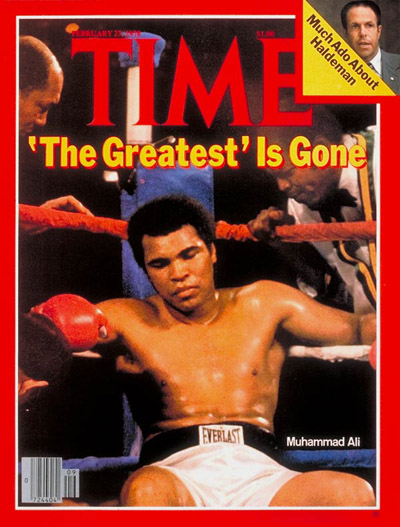
When Muhammad Ali was featured in TIME Magazine on Feb. 27, 1978, the cover bore the following words: “The Greatest” Is Gone.
The fight that had prompted the story, and the dramatic headline, was a bout between Ali, then 36, and Leon Spinks, 24, that ended in a split decision—and with Spinks as the new heavyweight champion of the world. The most famous boxer in history, known worldwide, was celebrated as a man at the end of his career. But Ali said at the time that he wasn’t through yet. And, that autumn, he proved it, beating Spinks and becoming the first boxer to ever take the heavyweight championship three times. The headline on that article? Young Once Again.
TIME had covered Ali’s career from a brief mention in February of 1963—”All clowns in three rounds,” the magazine quoted him saying—and his first cover story later that year, to his later years as an author and the subject of the biopic Ali (another cover story, at least for international editions). Throughout, Ali proved it should have been no surprise that every time he seemed knocked out, he came back. It was true in the ring and elsewhere, as when the Supreme Court in 1971 decided that the draft board’s decision to reject his conscientious-objector status during the Vietnam War, a decision that had resulted in his being stripped of his title, had been tainted by what TIME called an “admittedly erroneous attack on Ali’s sincerity and religion.”
He had in fact promised as much his title had been taken away: that no matter what the world or the sport or life did to him, he wasn’t going anywhere. As TIME quoted him in a cover story about his return to fight Joe Frazier in 1971:

Perhaps some of today’s boxers will take that promise seriously, imagining Ali haunting the ring forever—but even the most skeptical among us can probably admit that, as a metaphor, that promise is unlikely to go unkept.
As it was put at the end of the 1978 cover story, the one that guessed too early that Ali’s career was over, the boxer had the power to “make time stand still—for a little while.”
“Muhammad Ali careened across his stage, by turns as hopeful and despairing as his time,” the story concluded. “He is unlikely to go quietly into the past.”
Read TIME’s first cover story about Muhammad Ali—then Cassius Clay—here in TIME’s archives: The Dream
Read George Plimpton’s essay on Muhammad Ali from TIME’s 100 Heroes and Icons of the 20th Century issue: The Greatest
For much more on Muhammad Ali, see TIME’s ALI: The Greatest, a 112-page, fully illustrated commemorative edition. Available at retailers and at AMAZON.COM
More Must-Reads from TIME
- Cybersecurity Experts Are Sounding the Alarm on DOGE
- Meet the 2025 Women of the Year
- The Harsh Truth About Disability Inclusion
- Why Do More Young Adults Have Cancer?
- Colman Domingo Leads With Radical Love
- How to Get Better at Doing Things Alone
- Michelle Zauner Stares Down the Darkness
Write to Lily Rothman at lily.rothman@time.com